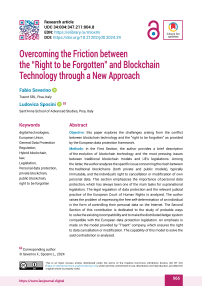Overcoming the Friction between the “Right to be Forgotten” and Blockchain Technology through a New Approach
Автор: Severino F., Sposini L.
Журнал: Journal of Digital Technologies and Law @lawjournal-digital
Рубрика: Государство и право. Юридические науки
Статья в выпуске: 2 (3), 2024 года.
Бесплатный доступ
Objective: this paper explores the challenges arising from the conflict between blockchain technology and the “right to be forgotten” as provided by the European data protection framework. Methods: in the First Section, the author provides a brief description of the evolution of blockchain technology and the most pressing issues between traditional blockchain models and UE’s legislations. Among the latter, the author analyzes the specific issue concerning the clash between the traditional blockchains (both private and public models), typically immutable, and the individual’s right to cancellation or modification of own personal data. This section emphasizes the importance of personal data protection, which has always been one of the main tasks for supranational legislators. The legal regulation of data protection and the relevant judicial practice of the European Court of Human Rights is analyzed. The author raises the problem of expressing the free self-determination of an individual in the form of controlling their personal data on the Internet. The Second Section of this contribution is dedicated to the study of probable ways to solve the existing incompatibility and to make the distributed ledger system compatible with the European data protection legislation. An emphasis is made on the model provided by “Traent” company, which ensures the right to data cancellation or modification. The capability of this model to solve the said contradiction is analyzed. Results: the study delves into the peculiar features of the new model to understand how it strategically utilizes the advantages of public and private blockchains guaranteeing not only the validity and authenticity of the chain where the transaction was performed, but, most importantly, the modification and granular cancellation of client’s personal data. This innovative solution offers a potential path forward for navigating the complex intersection of data privacy and blockchain innovation in the European context. Scientific novelty: Traent has implemented a “hybrid” model blockchain that, incorporating both public and private components, to achieve an effective compliance with the European Union regulations, especially those concerning data protection and privacy. Practical significance: the obtained conclusions and proposals can be taken into consideration in improving the compliance of blockchain technologies with the European Union General Data Protection Regulation.
Digital technologies, European Union, General Data Protection Regulation, Hybrid blockchain, law, Legislation, Personal data protection, private blockchain, public blockchain, right to be forgotten
Короткий адрес: https://sciup.org/14130868
IDR: 14130868 | УДК: 34:004:347.211:004.8 | DOI: 10.21202/jdtl.2024.29


